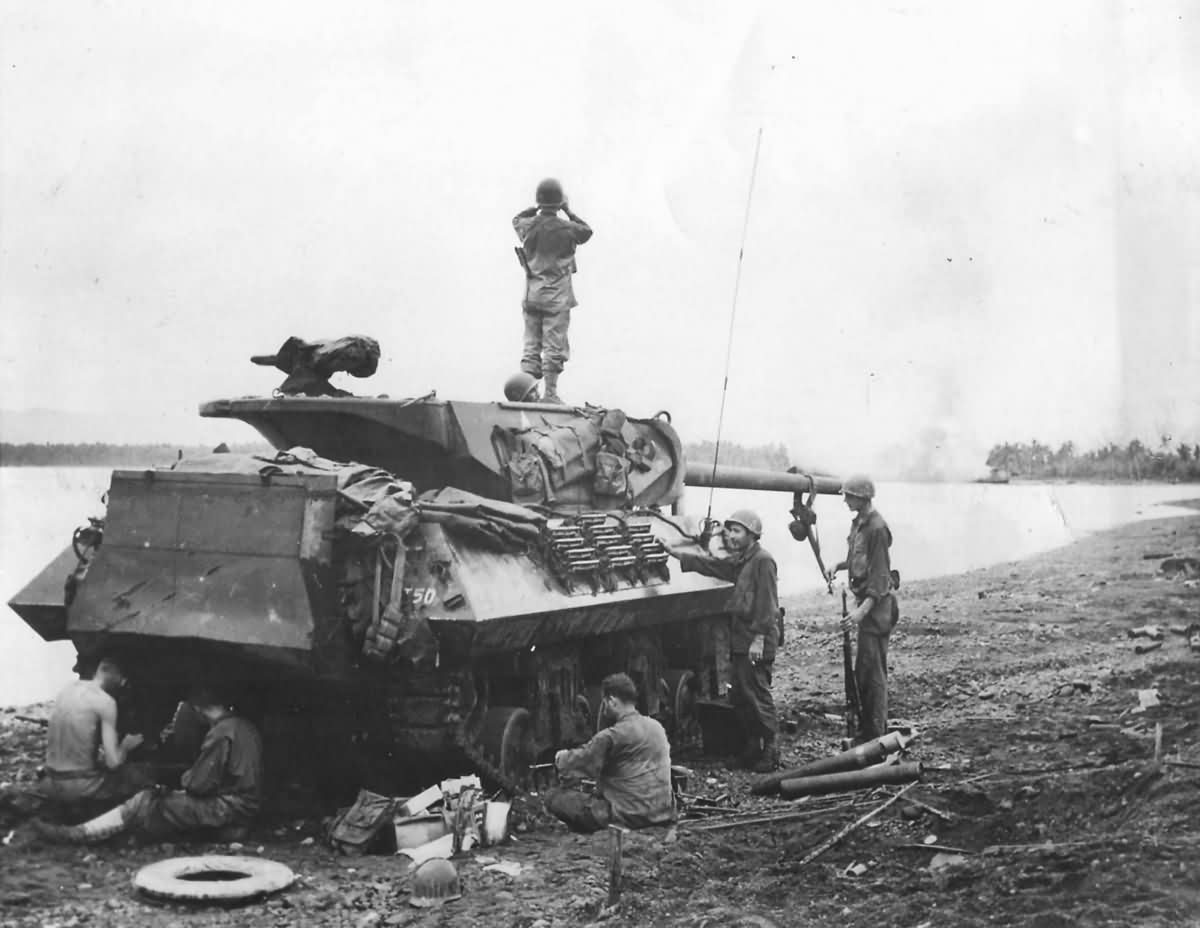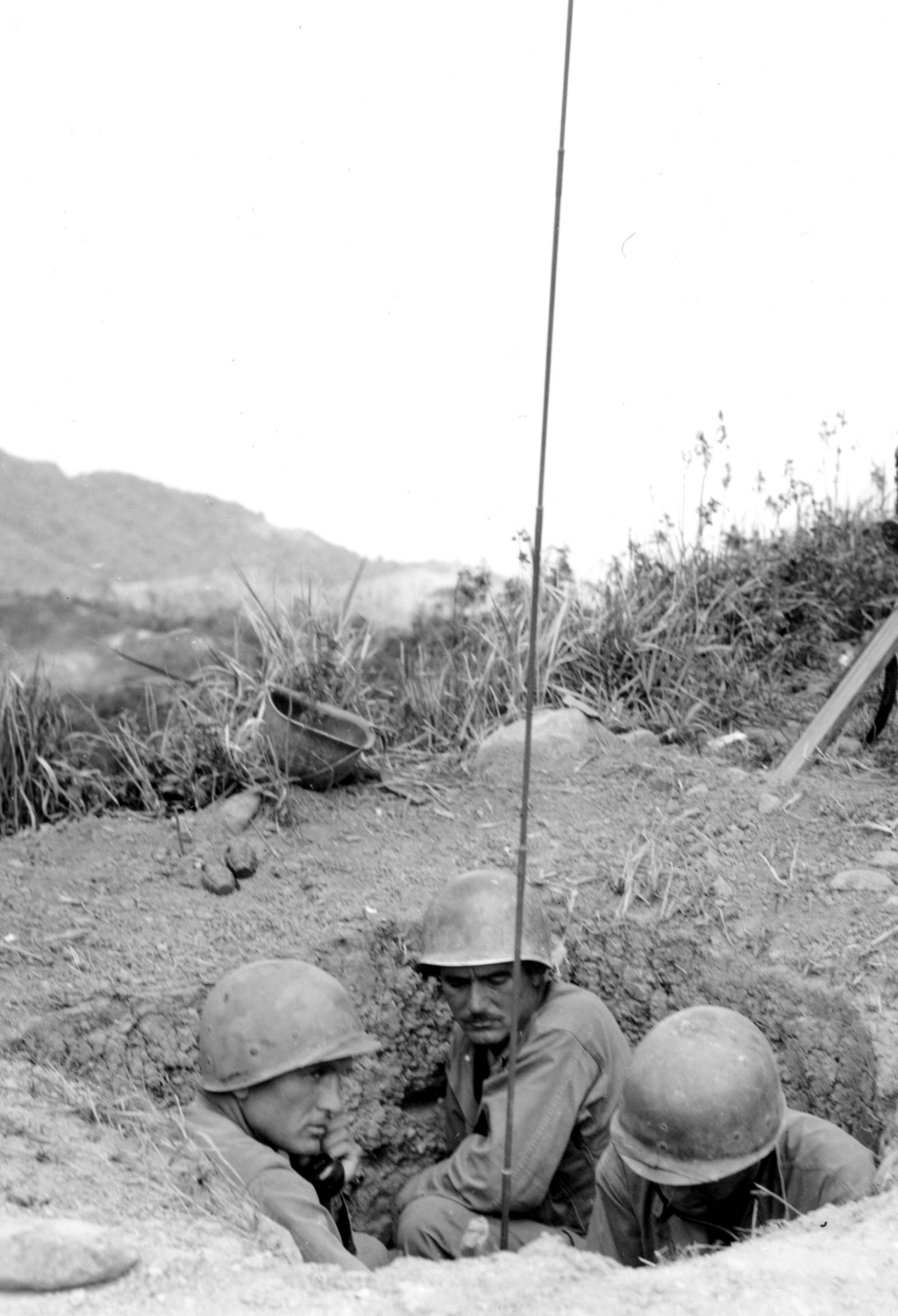The 77-ID’s plan was to hold this beachhead until the balance of the division and additional supplies arrived on D+2. However, Gen A. D. Bruce (CG 77-ID), after observing the complete success of the landing decided to order the 307-IR to make an immediate attack to the north and capture Ipil. This attack was to be followed the next morning by an all-out attack against Ormoc. Gen Bruce sent the following message to the XXIV Corps and to the 6-A Headquarters: Come Seven, Come Eleven, Double Seven Has Landed, indicating that the 7-ID from the south and the 11-A/B from the east could now move as a result of the 77-ID offensive action. The contents of this message were disseminated to all troops of the division. The significant message bolstered morale and contributed greatly to the release of the tension caused by the D-day landing.
The Island of Leyte is divided by a very high mountain range running from north to south. These mountains are covered with dense jungles and rough terrain. The east coast consisted of two valleys. The eastern valley was held by US Forces and the western by Japanese Forces. The valley near the west coast now became the area of operations for the 77-ID. It had the usual small streams, rice fields, and numerous finger ridges extending generally east to west. The terrain was rather open with patches of woods throughout the area. Further inland from the valley the terrain became very rough and difficult to traverse. Operations would have to be conducted along the coastline if the attacker was to have an advantage. The weather was fair and mild during this operation. On D-Day, Dec 7, sufficient supplies were carried with troops for three days of operations. Division Supply Agencies carried an additional amount. It was expected that the D+2 convoy would resupply the Division; thereafter the 6-A would supply the Division. No difficulties were encountered in resupplying the Division.
DISPOSITION AND FLANKS 306-IR
The 2/306-IR was attached to the 307-IR. HQs 306 was not due to the beachhead until D+2. Gen Bruce decided to attack. The 307-IR in the assault echelon was to attack the next day to the north. The plan of maneuver required the 305-IR to protect the Divisions’ beachhead. Each night the beachhead was to move to the area captured by the assault Regiment. Late in the afternoon of Dec 7, Col Stephen S. Hamilton, CO of the 307-IR, issued his attack order for 0800 on Dec 8. The Division objective was Ormoc, the Regimental objective was Camp Downs. The line of Departure was the beachhead line. The 3/307 and the 2/306 were to assault the 2/306 on the exposed right flank. Each Battalion is to attack in a zone about 50 yards wide.
BATTALION SITUATION
On Dec 7, the Battalion had landed twenty minutes after the first wave hit the shore. It had immediately organized and was disposed on a front of approximately 1700 yards in the center of the beachhead perimeter. Patrols were sent out to the front. No action of major importance had taken place between the Battalion and Japanese Forces, but the Battalion was prepared to meet a counter-attack the next day. It had just completed a very successful operation on Guam. Although the fighting had been severe at times, the casualties had been very light. Everyone was anxious to go after the Japs again and finish the war. The Battalion had collected and placed its supplies in the Battalion supply point. Due to the shortage of landing craft, only one-third of its vehicles were placed under Battalion control. The terrain was so difficult, that all heavy weapons had to be hand-carried as well as ammunition. Many Philippinos volunteered their services to the Battalion Supply Officer thus relieving a lot of additional vehicles. The terrain in the immediate zone of operation was fairly open, except where patches of woods covered the ridgelines and stream beds. Two prominent hills dominated the approaches to Camp Downs and were considered the critical terrain features in the Battalion zone. There was one dangerous avenue of approach into the Battalion zone of action. This approach was covered with trees and entered the Battalion zone of action from the east and along the right of the first hill. Upon receipt of the attack order, the Battalion Command Group made its recon. No Japs were encountered. Unless the Japs moved up at night it appeared that the Battalion would be able to jump off into its attack without difficulties. The Battalion Commander then issued his attack order about two and a half hours prior to darkness.
BATTALION PLAN OF ATTACK
The Battalion plan was to move out of the beachhead in a column of companies, just before arriving at the first hill it was to deploy with two companies abreast, Easy Co on the left, Fox Co on the right, George Co in reserve. An artillery preparation had been requested by the Battalion. The 307-IR had not sent an Artillery Liaison Officer nor any forward observers. They were expecting the following morning. The Battalion machine gun platoons were to be in direct support, one with each assault company. The 81-MM mortars were in general support. The Battalion AT Platoon, due to the effectiveness of its 37-MM gun, was armed with Browning Automatic Rifles (BAR) and used for special patrols and security groups. During the attack, a detachment protected the Command Group of the CP and the balance was used for security in the Battalion’s rear area. The time of the attack was 0800 on Dec 8. The boundary with the 3/307 was the highway leading to Ormoc. The Reserve Company was given the mission of right flank security. It was to move by bounds on the order of the Battalion CO. Flank patrols from the reserve were not to exceed one squad. The Battalion aid Station was located initially in a draw just south of the first objective. The Battalion Supply point was located near the road leading to Ormoc, approximately 1200 yards south of the Line of Departure.
FINAL PREPARATION – MOVEMENT TO THE LINE OF DEPARTURE
Upon receipt of the Battalion attack order of the Company and Platoon Commanders made their recon and the troops prepared for the attack. Battalion patrols continued to in a radius of 1000 yards to the front. The individual equipment of the soldier in this operation included his herringbone twill uniform, combat boots, web belt, steel helmet, trench knife, individual weapon, two bandoleers of ammunition, poncho which he carried in his belt, three hand grenades, a spoon, and one third-ration. Very few men carried in their pockets their pack. Extra and drawers were carried in their pockets. The men stripped down to essentials. All gas masks were carried by the Battalions S-4 and were available for issue on short notice. The Battalions Communications SOP was checked. Radios were to be used with companies. The Battalion Command Group included a communication team that provided a wireline from the Battalion OP to CP.
NARRATION
ATTACK OF THE INITIAL OBJECTIVES
At 1800, Dec 8, the 2/306-IR jumped off in the attack from the beachhead line. No Artillery observer or Liaison Officer had reported, so the Battalion crossed the line of departure without artillery preparation. Assault Easy Co and Fox Co moved slowly but steadily. Just as the assault was started on the initial objectives the Japs opened up. Japs employed machine guns, mortars, and infantry riflemen. This position was evidently the Japs combat Outpost Line. They soon withdrew to the north. Casualties for both sides were very few. The Battalion command group, consisting of the Battalion CO, S-3, S-2, the Communication Teams, and the Security Group, maintained a CP that moved along with the rear elements of the two assault Companies. The CO, Col William D. Cavness, was very aggressive in his actions. He always appeared at the point that did the Battalion the most good and was readily available to make decisions on the spot. The communications during this period had been exceptionally good. The wire from CP to Battalion CP was functioning well and all radio nets were working in good order. All during the attack, the Battalion Commander had a wire with the CP and Regimental CP. George Co, in reserve, was moved into an assembly area that covered the main avenue of approach. They were in a good position to meet enemy counter-attacks on the Battalion’s exposed right flank.
At about 0930, just as the assault echelon was about to gain the first objective, an artillery forward observer reported to the Battalion Commander. He was immediately dispatched to Fox Co on the right. Fox Co was on the exposed flank and its portion of the objective was placed on higher ground. Thirty minutes after this forward observer reported to Fox Co, he and his radio operator were killed by enemy fire. This was ironic because the first thing the forward observer did when he opened his radio was to report to the regiment that the enemy opposition was very weak. The Battalion supporting weapons continued to take over as much of the role of artillery as possible. Another artillery observer was requested. The Jap forces opposing the Battalion were identified as elements of the 12th and 13th Regiments. One unit was identified as the last Machine Gun Company. They appeared to be well-trained and well-disciplined troops. It was very difficult to spot their individual positions until after they had opened fire and inflicted several casualties. Their camouflage was superior. Some small-caliber Jap artillery was received in the Battalion area, apparently 77-MM and 40-MM anti-aircraft guns. Most of the Jap artillery shelling was directed at the Division or the beachhead supply installation during this initial phase.
The Battalion aid station had moved up to within supporting distance of the advancing troops. Litter bearers boldly roamed the area for the wounded. The Battalion ammunition point had not moved from its original location. The Battalion captured its first objective at 1030. The momentum of its attack carried the leading elements beyond the objective to a small fordable stream.






















